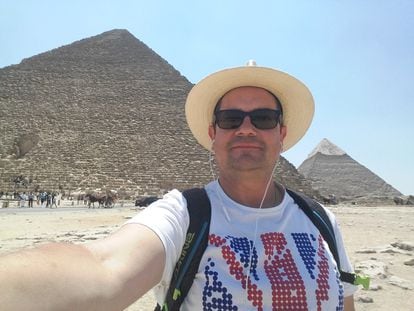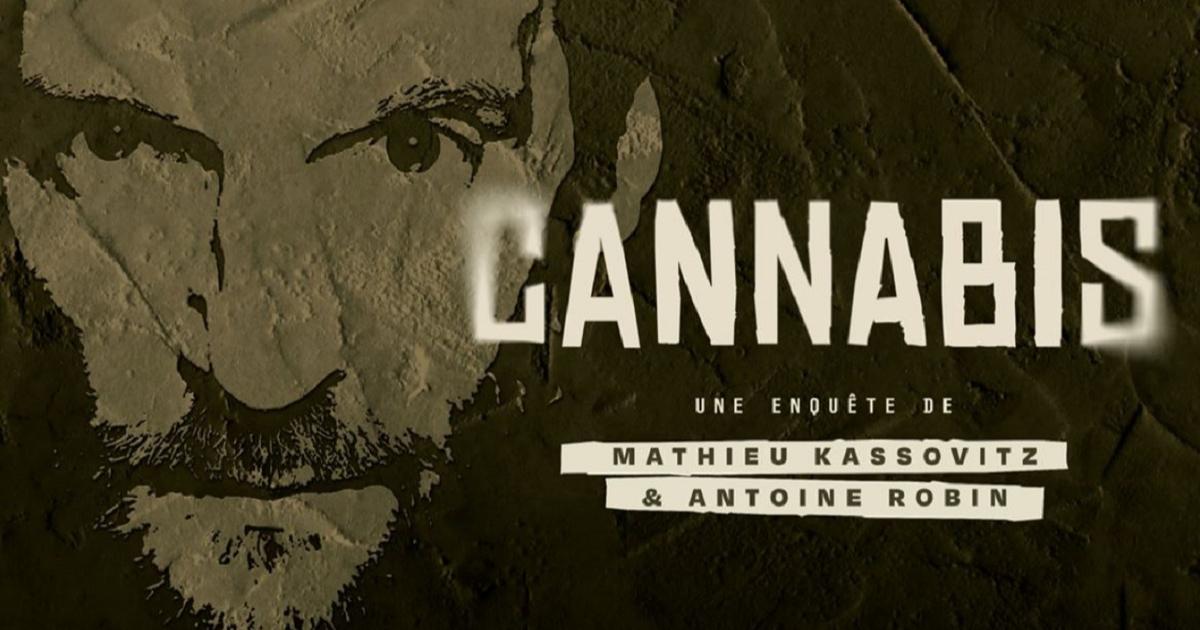Tour guides wait with their camel for the arrival of tourists next to the pyramids of Giza (Egypt).Hassan Ammar
It is logical to think that Pharaoh Cheops wanted to see how the construction of his pyramid was going, and of course he would not lack time to visit the works during the twenty years that, according to Herodotus (and Egyptologists agree), it took in lifting it.
The writer Nacho Ares (León, 51 years old) imagines that scene in his new historical novel,
The White Pyramid
(Grijalbo 2022), dedicated to explaining from fiction, but with great knowledge of the facts, how the most representative monument of Ancient Egypt was built.
The novel, which follows the construction of the pyramid from its first design on papyrus to the placement of the deceased Cheops inside it - the delivery of the keys, as it were -, has as its protagonists a priest of the temple of Ptah and a magician, a a builder troubled by the magnitude of the company and his daughter, and a son of the pharaoh with the pretense of an architect.
More information
The cursed Egyptian tomb was another
In the novel, Khufu is obsessed with getting a unique inviolable tomb and believes that the way to do it is to use magic, for which he enlists the wizard Djedi (a character credited in the
Westcar
papyrus ), who knows the secrets of the legendary secret sanctuary of Khufu. Thot.
Nacho Ares —who has studied Egyptology at the University of Manchester and is a popular disseminator of the pharaonic civilization, with numerous published works— handles the fictitious plot with great grace, mixing it with real elements of the construction of the Great Pyramid.
"You don't have to be very posh when writing a novel, when it comes to entertaining," says the author.
The novel gives us moments like the one in which the pharaoh observes the finished pyramid (in the absence of the electrum and gold pyramidion at the top): “Cheops looked up at the pyramid that stood before them with unusual majesty.
It was completely covered in white stone.
The glare of the sun made it almost impossible to look at her without covering her eyes with her hand.
It was splendid."
Ares has gone from the time of Amarna and the New Empire (
La hija del sol,
2017), more romantic, to the Old Kingdom, which is more sober.
"We know almost nothing about Cheops or the other pharaohs of that stage, there are many gaps that allow you to invent," says the novelist.
Isn't it a bit of a cheat to use magic to explain the construction of the Great Pyramid?
“Well, I'm a bit of a magician, a member of the Spanish Society of Illusionism, and I use my resources.
I liked the idea of linking the magic of Ancient Egypt, the one explained in the tales of the
Westcar
papyrus , for example, and which also included tricks, with the pyramid.
In pharaonic Egypt, illusionism and traditional magic came together in the concept of
heka,
They did not separate, as we do, esoteric magic from artistic, mechanical magic.
I literarily play with the creation of illusionism effects inside the monument to deceive possible intruders in the tomb of the pharaoh”.
Some episodes, without wishing to
spoil,
remember
The final trick (The prestige).
Ares acknowledges that the exact method of construction “remains an enigma”, although it seems clear that ramps were used (remains have been found).
He takes advantage of the theory proposed in 2006 (by the French architect Jean-Pierre Houdin and his father Henry Houdin) of an interior spiral ramp.
But he stresses that we still have a lot to learn about the Great Pyramid and "the last word has not yet been said" on the subject.
“I think there are more chambers than we know of and that we have baptized randomly (queen's chamber is like saying pipe kiosk, we don't know what it really is), some will be empty or full of sand, but it seems clear that there are gaps in the structure".
In this,
states that it follows the latest Waseda University analyzes that confirmed the mass anomalies and the recent microgravimetry and georadar study that demonstrated density variations in the monument (which, however, could simply be due to the difference in heat in the rock blocks).
In any case, "the debate allows me to create an invented interior structure", in which there is a secret chamber where the real burial of Cheops would be (the king's chamber would be a decoy or something else), arranged in a similar way to the that Herodotus mentioned: under the pyramid and surrounded by subterranean water diverted from the Nile, as in an island that would allude to mythology.
Ares points out that even the very Egyptologist Zahi Hawass believes in the possible existence of a hidden camera.
Nacho Ares, before the Great Pyramid.
In his novel, Ares, who personally distances himself from the esoteric theories of the "pyramidiots" and "Egyptologists", highlights the use of a rock outcrop on the Giza plateau on which the pyramid was built, taking advantage of the height of that base.
"That meant that so many stone blocks were not necessary, today we know that 25% of the pyramid is the volume of that natural rock and, therefore, not even 40% of the blocks that were calculated were necessary."
According to the writer, "the construction of the Great Pyramid is much simpler" than was believed, "there was talk of two million blocks, but with one and a half you can do it".
A million blocks… “Yes, of course, it's still a lot of work, I'm not saying it's easy, it still seems daunting to me”.
One of the best parts of the novel, along with the visits that Cheops surreptitiously makes to the pyramid under construction (not even the pharaoh himself has to know how the most secret interior is arranged, to avoid security breaches), is the assault by looters on the Red Pyramid of Seneferu, father of Cheops, in Dashur, the third largest in Egypt.
It is, and worth the word, a shocking passage.
“We have never seen an intact pyramid”, sighs Nacho Ares, “I loved imagining what it would be like to enter one of them intact for the first time, the terror that the thieves would experience in what was not only a theft of state property but also a sacrilegious desecration”.
Ares subscribes to the theory that the Sphinx of Giza predates the Great Pyramid.
“I'm not talking about Atlanteans, or Cayce archives, or bullshit, but maybe it's pre-Pharaonic and the Egyptians took advantage of a vaguely sculptural geological structure to shape it;
in any case, the attribution to Khafre is not at all clear, it could have been carved in the time of Cheops;
I allow myself to wink because, I insist,
The White Pyramid
is a novel”.
The writer has walked quite a bit inside the Great Pyramid, although he has not stayed to sleep like his friend and colleague Javier Sierra (to get used to writing his latest novel,
The Immortal Pyramid
)
.
“Yes, I have seen everything visible except the discharge chambers above the king's chamber.
It is a monument with lots of questions.
The truth is, to write about Egypt and its mysteries it is not necessary to resort to anything esoteric, the real enigmas are enough”.
Hollywood clichés and sex
Have you had to fight with the clichés of Hollywood when describing your pyramid in the novel?
“There are things that are difficult to eradicate, such as the false idea that the pyramids were built with slave labor.
Others, on the other hand, have been well explained, such as the sand-block enclosure system shown in
Land of Pharaohs
.
Though no one was buried alive and Joan Collins didn't stay inside."
There is little sex in
The White Pyramid.
which seems to go against the current in the narrative about Ancient Egypt, in which we have recently seen even Nefertiti in very compromising positions.
“I have been told;
well, everyone does what they want at home and it's my pyramid.
It's not that he's prudish.
At one point, the magician and the builder's daughter eat kisses.
Okay, it's not the most that can be done, especially with a short skirt…”.
Exclusive content for subscribers
read without limits
subscribe
I'm already a subscriber


/cloudfront-eu-central-1.images.arcpublishing.com/prisa/E6HHFF3LSBFABJJIUGGB5RHZBI.jpg)

/cloudfront-eu-central-1.images.arcpublishing.com/prisa/XQAXNSSRDZDYHAK7UD6NIQNQLU.jpg)
/cloudfront-eu-central-1.images.arcpublishing.com/prisa/CNZBUWS7XNGDJGRQV4JBJXJU2Q.jpg)

/cloudfront-eu-central-1.images.arcpublishing.com/prisa/ALIODPP46FDO7FZARDICIX4YS4.jpg)

